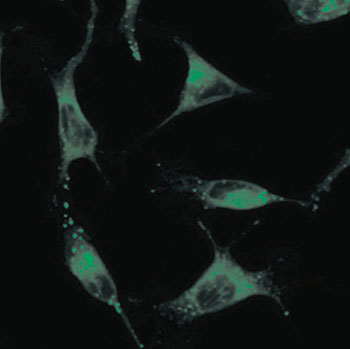Nanoparticles Designed to Deliver Drugs to Targeted Cells
By LabMedica International staff writers
Posted on 17 Jul 2014
Investigators are exploring the use and behavior of nanoparticles to deliver molecules to target cells. Posted on 17 Jul 2014
There is a great demand for the development of nanoparticles that can transport and deliver drugs to target cells in the human body. Researchers from the University of Miami (UM; Coral Gables, USA) have created nanoparticles that, under favorable settings, can self-assemble, ensnaring complementary guest molecules within their structure. These adaptable nanocarriers can travel in the aqueous environment encircling cells and transport their passenger molecules through the membrane of living cells to sequentially deliver their payload.

Image: The nanoparticles, which are capable of delivering and exchanging complementary molecules, emit a fluorescent signal that can be observed with a microscope (Photo courtesy of the University of Miami).
Although the transport of molecules inside cells with nanoparticles has been earlier achieved using various methods, researchers have developed nanoparticles capable of delivering and exchanging complementary molecules. For practical applications, these nanocarriers are highly desirable, reported Francisco Raymo, professor of chemistry in the University of Miami College of Arts and Sciences and lead investigator of the project. “The ability to deliver distinct species inside cells independently and force them to interact, exclusively in the intracellular environment, can evolve into a valuable strategy to activate drugs inside cells,” said Prof. Raymo.
The new nanocarriers are 15 nm in diameter. They are supramolecular constructs comprised of amphiphilic polymers. These nanocarriers hold the guest molecules within the boundaries of their water-insoluble core and use their water-soluble exterior to move through an aqueous environment. As a result, these nanovehicles are is suitable for transferring molecules, which would otherwise be insoluble in water, across a liquid environment.
“Once inside a living cell, the particles mix and exchange their cargo. This interaction enables the energy transfer between the internalized molecules,” said Prof. Raymo, director of UM’s laboratory for molecular photonics. “If the complementary energy donors and acceptors are loaded separately and sequentially, the transfer of energy between them occurs exclusively within the intracellular space. As the energy transfer takes place, the acceptors emit a fluorescent signal that can be observed with a microscope.”
Crucial for this process are the noncovalent bonds that loosely hold the supramolecular constructs together. These weak bonds exist between molecules with complementary shapes and electronic characteristics. They are responsible for the ability of supramolecules to assemble spontaneously in liquid environments. Under the right conditions, the reversibility of these weak noncovalent contacts allows the supramolecular constructs to exchange their components as well as their cargo.
The research was conducted with cell cultures. It is not yet known if the nanoparticles can actually travel through the bloodstream. “That would be the dream, but we have no evidence that they can actually do so,” said Prof. Raymo. “However, this is the direction we are heading.”
The next step of this study involves demonstrating that this method can be used to do chemical reactions inside cells, instead of energy transfers. “The size of these nanoparticles, their dynamic character, and the fact that the reactions take place under normal biological conditions [at ambient temperature and neutral environment] makes these nanoparticles an ideal vehicle for the controlled activation of therapeutics directly inside the cells,” Prof. Raymo concluded.
The study’s findings were published in the Journal of the American Chemical Society.
Related Links:
University of Miami













